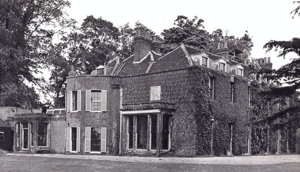Aston House facts for kids
Aston House was a large house built in the 1600s. It had big gardens and was located in Aston, Hertfordshire, in southern England. The house was torn down in 1961 by the Stevenage New Town Development Corporation. This group had used Aston House as their first main office. The area where the house stood is now called Yeomans Drive. This name remembers Arthur Yeomans, who owned the house in 1939 before the government took it over for the war. The land next to the house became the Stevenage Golf and Conference Centre in 1980.
Secret War Work: Station XII
During the 1940s, Aston House became a top-secret center for the Special Operations Executive (SOE). The SOE was a British organization that carried out secret missions during World War II. At Aston House, scientists and engineers invented special explosives and weapons for these missions.
Aston House was one of the first places to test plastic explosives for sabotage. Sabotage means secretly damaging things like enemy factories or bridges. The leader at Aston House was Colonel Leslie J. Cardew Wood. Many people think he was the real-life inspiration for 'Q', the gadget inventor in the James Bond movies! He created unique weapons, tools, and gadgets. These were used in famous raids like the Lofoten Islands, Dieppe, and the Norsk Heavy Water Plant mission.
Aston House also supplied special weapons to elite military groups. These included the Special Air Service (SAS), Special Boat Service (SBS), and the Commandos. They also helped design the Fairbairn–Sykes fighting knife, a famous combat knife.
The team at Aston House produced many important items. They made over 12 million "pencil detonators," which were small devices that could set off explosives after a delay. They also made 38,500 "limpet mines." These were special mines that could stick to ships using magnets. Both of these items were designed at Aston House.
The house was also responsible for checking the quality of these items. They packaged and sent them out to various groups. This included the Home Guard Auxiliary Units in Britain and Resistance groups across Europe. Their busiest time was around D-Day, the major invasion of Europe in 1944.
One of the most unusual inventions was the "explosive rat." These were real rats that were skinned and filled with plastic explosive. The idea was to place them near enemy boilers. If thrown into the coal, they would cause an explosion. Weapons from Aston House were also used in the assassination of Reinhard Heydrich, a high-ranking Nazi official. Many smart scientists worked there, including A.J.G. Langley, who invented the "timing pencil."
What's Left Today
The only part of Aston House that still stands is the old coach house. It has a clock tower and is located on Yeoman's Drive in Aston.


